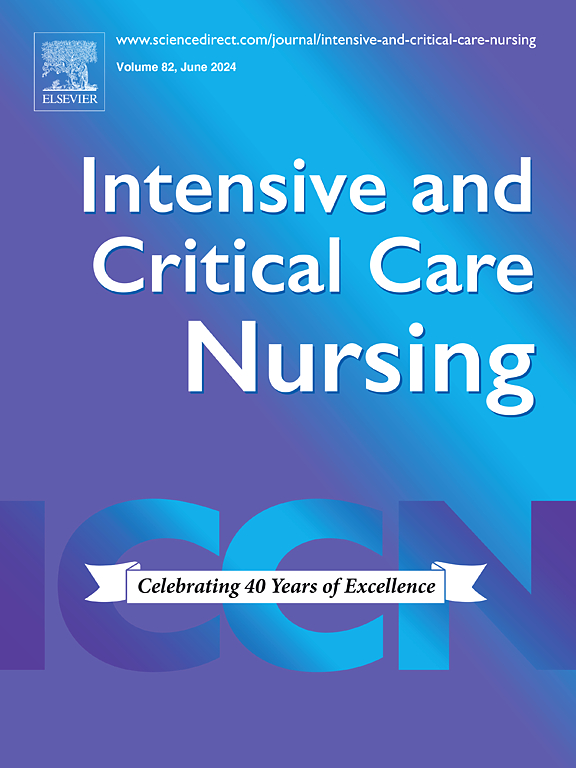What are the perceived barriers for nurses providing end-of-life care for patients and their families from culturally diverse backgrounds in ICU? An integrative review
IF 4.9
2区 医学
Q1 NURSING
引用次数: 0
Abstract
Background
Cultural diversity is increasing worldwide. The provision of end-of-life care for people who have culturally diverse rituals, customs and beliefs can present barriers for critical care nurses in delivering high quality end-of-life care.
Aim
To synthesise research evidence about the perceived barriers for critical care nurses providing end-of-life care for patients and their families from diverse cultural backgrounds in ICU.
Research Question
What are the perceived barriers for nurses providing end-of-life care for patients and their families from culturally diverse backgrounds in ICU?
Design
Following protocol registration, a structured integrative review was undertaken across Medline, Embase, APA PsycINFO, CINAHL Complete, Cochrane library, Google Scholar and ProQuest Dissertation and Theses Global databases. A total of 823 records were independently assessed against inclusion and exclusion criteria. All included studies were assessed for quality. Narrative synthesis was used to report findings.
Results
Fifteen studies published between 2010 and 2022 were included. Findings are presented according to four themes: (i) Language and communication, (ii) (Dis) Comfort with religion, (iii) Consensus challenges and (iv) Caring at the end of life.
Conclusion
Recognising cultural diversity provides opportunity for critical care nurses to build awareness and understanding of cultural diversity as a way of optimising end-of-life care, through routine cultural assessment, advocating for professional interpreters to enhance communication and demonstrating openness to diverse cultural needs, preferences and practices.
Implications for Clinical Practice
The obvious first step in countering perceived challenges to end-of-life care is to increase awareness by acknowledging and respecting difference and diversity. Cultural assessments for all patients admitted to critical care would be an ideal first step in addressing challenges associated with cultural diversity. Greater access to professional interpreters to overcome language barriers is also essential to optimising communication and consensus in decision-making at the end of life.
在重症监护病房,护士为来自不同文化背景的患者及其家属提供临终关怀时会遇到哪些障碍?综述。
背景:文化多样性在全球范围内日益增加。为具有不同文化礼仪、习俗和信仰的人提供临终关怀可能会给重症监护护士提供高质量的临终关怀带来障碍。目的:综合研究证据,说明重症监护病房中为来自不同文化背景的患者及其家属提供临终关怀的重症监护护士感知到的障碍:研究问题:重症监护病房护士为来自不同文化背景的患者及其家属提供临终关怀服务时,会遇到哪些障碍?在协议注册后,我们在 Medline、Embase、APA PsycINFO、CINAHL Complete、Cochrane library、Google Scholar 和 ProQuest Dissertation and Theses Global 数据库中进行了结构化综合综述。共根据纳入和排除标准对 823 条记录进行了独立评估。对所有纳入的研究进行了质量评估。研究结果采用叙事综合法进行报告:结果:纳入了 2010 年至 2022 年间发表的 15 项研究。研究结果按照四个主题进行阐述:(i) 语言与沟通;(ii) (Dis) 对宗教的适应;(iii) 达成共识的挑战;(iv) 临终关怀:认识到文化多样性为重症监护护士提供了机会,通过常规文化评估、倡导使用专业翻译人员以加强沟通,以及展示对不同文化需求、偏好和习俗的开放态度,建立对文化多样性的认识和理解,从而优化临终关怀:要应对临终关怀所面临的挑战,显而易见的第一步就是通过承认和尊重差异与多样性来提高意识。对所有接受重症监护的患者进行文化评估将是应对与文化多样性相关的挑战的理想的第一步。增加专业翻译人员以克服语言障碍,对于优化生命末期决策中的沟通和共识也至关重要。
本文章由计算机程序翻译,如有差异,请以英文原文为准。
求助全文
约1分钟内获得全文
求助全文
来源期刊

Intensive and Critical Care Nursing
NURSING-
CiteScore
6.30
自引率
15.10%
发文量
144
审稿时长
57 days
期刊介绍:
The aims of Intensive and Critical Care Nursing are to promote excellence of care of critically ill patients by specialist nurses and their professional colleagues; to provide an international and interdisciplinary forum for the publication, dissemination and exchange of research findings, experience and ideas; to develop and enhance the knowledge, skills, attitudes and creative thinking essential to good critical care nursing practice. The journal publishes reviews, updates and feature articles in addition to original papers and significant preliminary communications. Articles may deal with any part of practice including relevant clinical, research, educational, psychological and technological aspects.
 求助内容:
求助内容: 应助结果提醒方式:
应助结果提醒方式:


